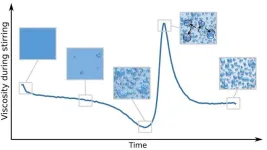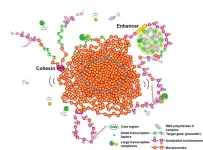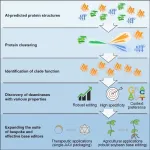(Press-News.org) Having a seat at the table, and voices heard, makes a world of difference when it comes to natural resources. It sounds intuitive, but experts didn’t have enough data to prove it until now.
A team of researchers from across the country pored over 108 groundwater management plans in California to see how well they protect stakeholders like domestic well users, farmers and ecosystems. They found that the plans that incorporated stakeholder input offered greater protection from groundwater depletion. Unfortunately, only 9% of the sustainability plans integrated these users in a comprehensive manner.
The findings have broad implications for resource management, both in California and abroad. The authors published their independent analysis in Nature Communications. The data and findings from this study were shared with different stakeholders and organizations, who have used it to inform policy recommendations.
“It’s a big deal that we found empirical evidence that stakeholder integration leads to better protection,” said co-lead author Debra Perrone, an assistant professor in UC Santa Barbara’s Environmental Studies Program. “There are very few published papers that show this connection empirically.”
“I was pretty stunned,” added co-lead author Courtney Hammond Wagner, formerly a postdoctoral scholar at Stanford University and now at the U.S. Department of Agriculture. “I thought this was going to be a different paper.”
An ambitious aim
By 2014, more than a century of unregulated pumping in California had dried up wells, depleted aquifers and even sunk the ground level in many parts of the state. Meanwhile, the region was gripped by unprecedented drought. In dire straits, California passed the Sustainable Groundwater Management Act (SGMA), the first statewide effort to regulate groundwater resources.
Recognizing the complexity of the task at hand, the new legislation took a decentralized approach to groundwater management. The state tasked newly formed, local groundwater sustainability agencies with bringing their basins into balance within 20 years by reducing pumping or increasing groundwater recharge. Plans also needed to avoid undesirable results such as:
lowering groundwater levels;
losing groundwater storage;
seawater intrusion,
land subsidence;
deteriorating groundwater quality;
and losing streamflow.
If a local agency failed to meet the sustainability targets as set, the State Water Resources Control Board would step in to take the helm.
A bevy of groundwater sustainability plans have come out since SGMA was passed. But because planning is a local process, it wasn’t clear how the effort was adding up overall. To answer this question, co-lead authors Perrone, Wagner and Melissa Rohde worked in collaboration with a forum of NGOs tackling groundwater issues in California. Together, they evaluated how well the sustainability plans integrated and protected stakeholders.
Evaluating impact
The authors surveyed 108 management plans, encompassing more than 160,000 pages of text. They came up with a rubric to evaluate stakeholder integration across three groups: domestic users, agriculture and ecosystems. The authors looked at how informed stakeholders were, how much representation they had, and whether their water needs were integrated into the plans. Most importantly, they examined whether stakeholder input had an impact on the protection of wells and ecosystems in the final plan.
How well a plan protected various stakeholders depended on where it set the aquifer’s minimum thresholds, namely the lowest the water table can dip before potentially causing an undesirable result. Only wells deeper than the minimum threshold are protected by the management plan, and the same is true for plant roots in ecosystems. For the sake of caution, the authors also assumed that any well or ecosystem more than 1.5 miles away from a monitoring well was not protected.
Groundwater users and ecosystems are only protected by a management plan if their wells or roots extend below the minimum threshold the policy established for the underlying aquifer. Otherwise, their access to water can’t be guaranteed.
The study distills years of painstaking analysis. It took an entire summer to train the eight co-authors who combed through the lengthy technical documents, and another year and a half to actually go through the management plans.
“I was disappointed to see how many of the state’s wells and ecosystems are not being protected by SGMA,” said Rohde, an independent environmental consultant who worked at The Nature Conservancy during the study. A mere 9% of plans integrated all three stakeholder groups. The 108 management plans failed to protect 60% of agricultural wells, 63% of domestic wells and 91% of groundwater-dependent ecosystems. What’s more, 40% of the state’s wells and 87% of the state’s groundwater-dependent ecosystems are outside the basins regulated by SGMA.
These shortcomings were especially true for stakeholders with less political and economic power, like small farms and disadvantaged communities, terms that are defined by the state and federal governments. “Economically vulnerable groups were not only less integrated into the planning process, but they were also less protected,” Perrone said.
However, in the few cases where stakeholders were integrated into the planning process, management policies protected their interests rather well. “This suggests that if we can design our policies to more explicitly require stakeholder integration, we can likely get better outcomes for stakeholders,” Perrone explained.
“I did not think we would find a relationship between stakeholder integration and protection,” Wagner added, noting how many variables can affect a policy’s outcome: geography, climate, economics, demographics, etc. “And yet,” she said, “we still saw a strong indication that stakeholder integration was associated with better protection. That blew me away.”
Broad implications
SGMA was designed with adaptation in mind. Legislators knew it wouldn’t be perfect at first, so they built in opportunities to evaluate and improve. This study presents one such evaluation and offers the chance to correct course.
That said, the stakes are high. Farmers and communities are running out of water and ecosystems are in decline. So, if management plans aren’t protecting stakeholders, are they failing?
“SGMA is unfortunately not living up to its fullest intent, in the sense that a large majority of wells and ecosystems are not being protected by these groundwater sustainability plans,” Rohde said. “But, the results are also a reminder of how difficult it can be to fully engage diverse stakeholder groups with different needs and values, especially after a long legacy of groundwater depletion.”
“SGMA is a great example of how discretion is a double-edged sword,” Perrone added. “It offers a lot of flexibility, which is great for local control, but it’s at the cost of concrete guidance.”
“To correct course,” Rohde said, “state and local agencies need to be more intentional about ensuring that everyone is at the table and has the technical and financial resources to integrate their water needs into the plans.”
Sustainability policies are on the rise globally to address some of society’s tough challenges, such as climate change, biodiversity loss and natural resource depletion. “But in order to be successful, these plans must intentionally be inclusive of diverse stakeholder needs, especially those groups that have been disenfranchised or historically marginalized,” Rohde said.
END
The more stakeholders are included in policy planning, the better those policies protect them
Researchers pored over 108 groundwater management plans in California, finding those that incorporated stakeholder input offered greater protection from groundwater depletion
2023-06-27
ELSE PRESS RELEASES FROM THIS DATE:
Penn State researchers use ultrasound to control orientation of small particles
2023-06-27
UNIVERSITY PARK, Pa. — Acoustic waves may be able to control how particles sort themselves. While researchers have been able to separate particles based on their shape — for example, bacteria from other cells — for years, the ability to control their movement has remained a largely unsolved problem, until now. Using ultrasound technology and a nozzle, Penn State researchers have separated, controlled and ejected different particles based on their shape and various properties.
They ...
Fondant: Where baking and thermodynamics mix
2023-06-27
WASHINGTON, June 27, 2023 – With their unique appearance, texture, and mouthfeel, fondants have intrigued bakers and physicists for years. They present an appetizing enigma in the world of confectionery, an intriguing combination of sugar, water, and heat that, when manipulated correctly, yields a delectably creamy product.
Researchers from the Max Planck Institute for Polymer Research and Technische Universität Berlin studied the kinetic and thermodynamic processes of sugar crystallization in the making of fondant. In Physics of Fluids, by AIP Publishing, they combined a controlled kneading machine with light microscopy ...
Prevalence of iron deficiency, iron-deficiency anemia in females ages 12-21
2023-06-27
About The Study: Among 12- to 21-year-old U.S. females between 2003 and 2020, iron deficiency affected almost 40% and iron deficiency anemia affected 6%, with variation by the ferritin or hemoglobin thresholds used. Menstruation was a risk factor for both, but more than one-quarter of premenarchal individuals had iron deficiency.
Authors: Angela C. Weyand, M.D., of the University of Michigan Medical School in Ann Arbor, is the corresponding author.
To access the embargoed study: Visit our For The Media website at this link https://media.jamanetwork.com/
(doi:10.1001/jama.2023.8020)
Editor’s Note: Please see the article for ...
Team proposes a new view on euchromatin in the cell
2023-06-27
In their paper the team discusses their novel view of euchromatin in the cell and shows how the revealed organization is relevant to genome functions. “Our ultimate goal is to reveal how genomic information is searched and read out in living cells,” said Kazuhiro Maeshima, a leading author and a professor with the National Institute of Genetics and SOKENDAI, Japan.
Chromatin describes the combination of DNA and proteins in the cells of humans and other eukaryotes. According to typical textbook models, chromatin occurs in two forms— euchromatin, that is less condensed and can be transcribed, and heterochromatin, that is more condensed and usually not transcribed. ...
Monitoring British bats can help identify coronaviruses with pathogen potential
2023-06-27
Researchers who found novel coronaviruses in UK bats say genetic surveys of the viruses should be regularly conducted, even if none of those viruses can infect humans yet.
Working with a network of bat conservationists, a research team led by Imperial College London and University College London researchers screened faecal samples from UK bats for coronaviruses.
Their results, published today in Nature Communications, report circulation of four species of coronaviruses, including two novel ones, among the 16 UK bat species sampled. While some of these ...
Chemical imbalance in the forebrain discovered in people with obsessive-compulsive disorder
2023-06-27
Using a high-powered MRI scanner, scientists have discovered an imbalance between neurochemicals in parts of OCD patients’ brains key to decision-making and habit.
Chemical imbalances were related to OCD symptom severity, as well as habitual tendencies in a decision-making task.
A similar but less pronounced neurochemical imbalance was also detected in healthy individuals with milder compulsive tendencies.
Neuroscientists argue that the findings are a “major piece of the puzzle” in understanding OCD, and could open up new ...
Researchers develop new base editing tools using AI-predicted protein structure clustering
2023-06-27
GAO Caixia's group from the Institute of Genetics and Developmental Biology of the Chinese Academy of Sciences has pioneered the use of artificial intelligence (AI)-assisted methods to discover novel deaminase proteins with unique functions through structural prediction and classification.
This approach has opened up a range of applications for the discovery and creation of desired plant genetic traits.
The results were published in Cell.
The discovery of new proteins and the exploitation of diverse engineered enzymes have contributed to the rapid advancement of biotechnology. Currently, efforts to mine novel proteins ...
New study sheds light on the evolution of animals
2023-06-27
Key points:
Scientists have been mystified as to why animals are missing in much of the fossil record;
Researchers have developed a new method to determine if animals really were absent during certain geological eras, or if they were present but too fragile to be preserved;
The findings establish a new maximum point at which animals first evolved on Earth.
A study led by the University of Oxford has brought us one step closer to solving a mystery that has puzzled naturalists since Charles Darwin: when did animals first appear in the history of Earth? The results have been published ...
Associations between socioeconomic status, obesity, cognition, and white matter microstructure in children
2023-06-27
About The Study: Neighborhood and household contexts were associated with white matter development in children, and findings suggested that obesity and cognitive performance were possible mediators in these associations. Future research on children’s brain health may benefit from considering these factors from multiple socioeconomic perspectives.
Authors: Scott Marek, Ph.D., and Tamara Hershey, Ph.D., of the Washington University in St. Louis School of Medicine, are the corresponding authors.
To access the embargoed study: Visit our For ...
Humans' ancestors survived the asteroid impact that killed the dinosaurs
2023-06-27
A Cretaceous origin for placental mammals, the group that includes humans, dogs and bats, has been revealed by in-depth analysis of the fossil record, showing they co-existed with dinosaurs for a short time before the dinosaurs went extinct.
The catastrophic destruction triggered by the asteroid hitting the Earth resulted in the death of all non-avian dinosaurs in an event termed the Cretaceous-Paleogene (K-Pg) mass extinction. Debate has long raged among researchers over whether placental mammals were present alongside the dinosaurs before the mass extinction, ...
LAST 30 PRESS RELEASES:
New study highlights link between eviction rates and gun violence
Heatwaves heat up soil but not toxin levels in rice, study finds
Digital modeling reveals where construction carbon emissions really come from
Turning farm waste into water filters
New study shows how the spleen helps the immune system accept a transplant
New Mayo Clinic study advances personalized prostate cancer education with an EHR-integrated AI agent
Researchers identify novel therapeutic target to improve recovery after nerve injury
Microbes in breast milk help populate infant gut microbiomes
Reprogramming immunity to rewrite the story of Type 1 diabetes
New tool narrows the search for ideal material structures
Artificial saliva containing sugarcane protein helps protect the teeth of patients with head and neck cancer
Understanding the role of linear ubiquitination in T-tubule biogenesis
Researchers identify urban atmosphere as primary reservoir of microplastics
World’s oldest arrow poison – 60,000-year-old traces reveal early advanced hunting techniques
Bristol scientists discover early sponges were soft
New study uncovers how rice viruses manipulate plant defenses to protect insect vectors
NSF–DOE Vera C. Rubin Observatory spots record-breaking asteroid in pre-survey observations
Ribosomal engineering creates “super-probiotic” bacteria
This self-powered eye tracker harnesses energy from blinking and is as comfortable as everyday glasses
Adverse prenatal exposures linked to higher rates of mental health issues, brain changes in adolescents
Restoring mitochondria shows promise for treating chronic nerve pain
Nature study identifies a molecular switch that controls transitions between single-celled and multicellular forms
USU chemists' CRISPR discovery could lead to single diagnostic test for COVID, flu, RSV
Early hominins from Morocco reveal an African lineage near the root of Homo sapiens
Small chimps, big risks: What chimps show us about our own behavior
We finally know how the most common types of planets are created
Thirty-year risk of cardiovascular disease among healthy women according to clinical thresholds of lipoprotein(a)
Yoga for opioid withdrawal and autonomic regulation
Gene therapy ‘switch’ may offer non-addictive pain relief
Study shows your genes determine how fast your DNA mutates with age
[Press-News.org] The more stakeholders are included in policy planning, the better those policies protect themResearchers pored over 108 groundwater management plans in California, finding those that incorporated stakeholder input offered greater protection from groundwater depletion




